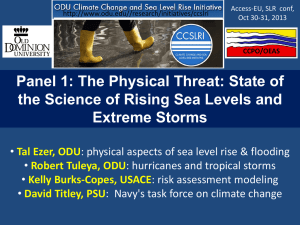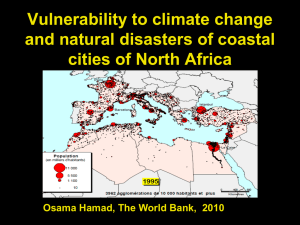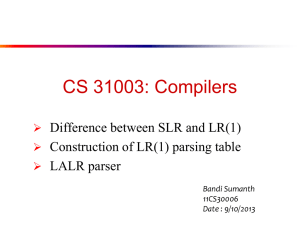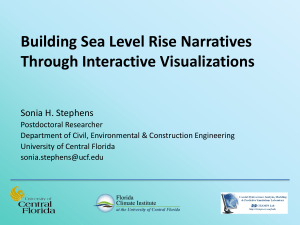Bath COAST Report December 2013
advertisement
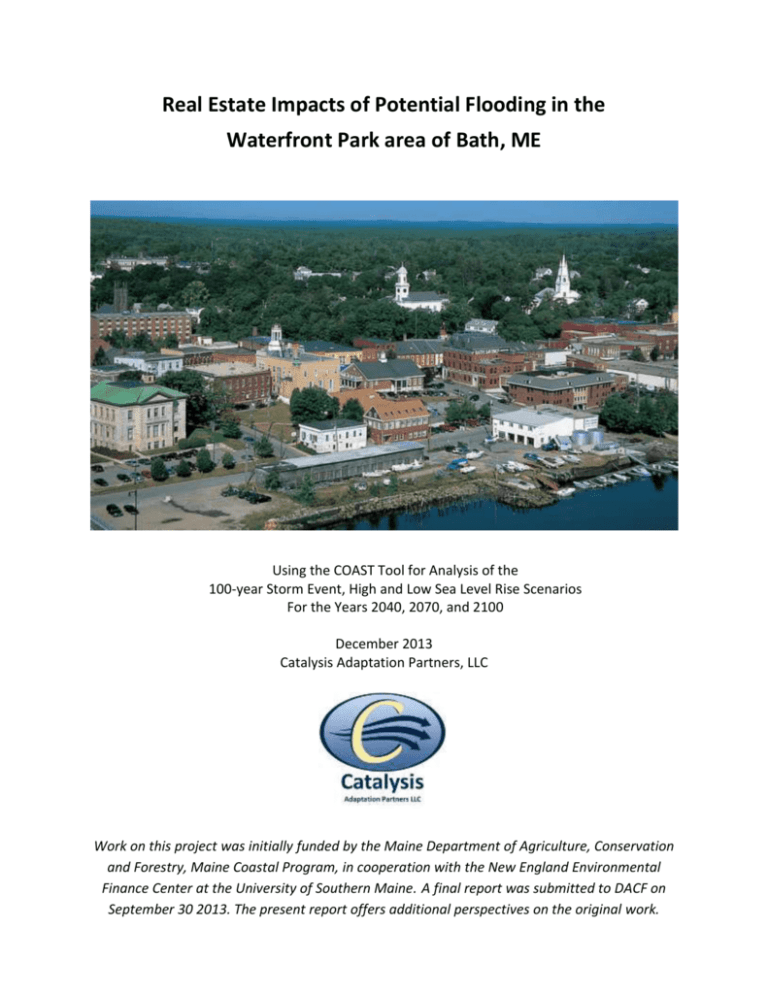
Real Estate Impacts of Potential Flooding in the Waterfront Park area of Bath, ME Using the COAST Tool for Analysis of the 100-year Storm Event, High and Low Sea Level Rise Scenarios For the Years 2040, 2070, and 2100 December 2013 Catalysis Adaptation Partners, LLC Work on this project was initially funded by the Maine Department of Agriculture, Conservation and Forestry, Maine Coastal Program, in cooperation with the New England Environmental Finance Center at the University of Southern Maine. A final report was submitted to DACF on September 30 2013. The present report offers additional perspectives on the original work. Introduction COAST (COastal Adaptations to Sea level rise Tool) predicts damages to assets vulnerable to sea level rise and storm surge. It calculates damages from single storm events as well as cumulative damages from all storms over decadal time frames. The tool was developed through the New England Environmental Finance Center (EFC) at the Muskie School of Public Service, University of Southern Maine with support from the US EPA. In summer 2013 the EFC conducted a noadaptation-action run of the COAST tool for the City of Bath, Maine, in collaboration with the Maine Coastal Program of the Maine Department of Agriculture, Conservation, and Forestry. A final report was submitted on this project in September 2013. This document is a supplement to that report, overwriting it in some parts and elaborating in others. It provides additional time frames, tables, and figures; identifies particular parcels that become permanently inundated by sea level in the downtown area of Bath and when; and discusses implications of these results for development or redevelopment concerns and opportunities in the area. Methods A LiDAR (Light Detection and Ranging) image of the waterfront area was obtained from the Maine Geological Survey (grid resolution 2M) along with a parcel map for spatial reference of vulnerable real estate. These data layers were converted to the same coordinate system (UTM Zone 19N) and linear units (meters). An exceedance curve was created with probabilities of given-sized storms, using FEMA’s most recent local Flood Insurance Study from the area. Overall Elevation of Flood Waters in Feet Storm Event Probability in Any Given Year Surge Height Above MHHW of 3.022 ft. 500 Year Storm 0.002 7.1 10.1 100 Year Storm (the “1% Storm) 0.01 5.9 8.9 50 Year Storm 0.02 5.3 8.3 10 Year Storm 0.1 4.4 7.4 From the Bath FIS, 1986 1 Sea level rise values were then added to these flood heights using parameterizations from a COAST iteration performed in Portland, Maine in 2011 (Vermeer and Rahmsdorf 2009, as cited in Merrill et al. 2012): Low Sea Level Rise Scenario High Sea Level Rise Scenario By the year 2040, an additional 0.22 feet. By the year 2040, an additional 1.4 feet. By the year 2070, an additional 0.42 feet. By the year 2070, an additional 3.5 feet. By the year 2100, an additional 0.7 feet. By the year 2100, an additional 6.6 feet. To determine the amount of real estate value lost for each 1’ of inundation, a US Army Corps of Engineers Depth-Damage Function (DDF) for commercial real estate was incorporated into the COAST software shell. Other parameterization metrics followed earlier regional work (Merrill et al. 2012), including selection of appropriate subsidence rates (0.00072 ft/yr), to help specify local sea level rise rates as distinct from global sea level rates. Unlike in Merrill et al. (2012), however, a 0% discount rate was used for these simulations. In general, it is easier to understand and communicate to the public about COAST results that use present-day dollars than to include discounting. Also, discounting becomes much more important to consider when costs of adaptation actions are compared against the benefits (avoided costs) of taking that adaptation action. Because this was a no-action analysis, discounting was less necessary. Future work in Bath, that may involve benefit-cost evaluation of candidate adaptation actions versus doing nothing, could benefit from use of discounted future values. In this study, iterations of COAST then calculated lost building value from snapshot storm surge events and cumulatively over time. Parcels containing Bath Iron Works were not included in this study, because the largely industrial real estate there would have required substantially different depth damage functions than those used in this study, and because dollar value on those parcels is large enough to swamp values in other sections of the study area. Similarly, although initial simulations in the USM report encompassed Bowery Street, no assessment was done on the wastewater treatment plant located at the end of Bowery Street, because similar to facilities at Bath Iron Works, calculating real estate damages for a WWTP requires a tailored depth damage function and was outside the scope of this study. An additional caveat is that only stillwater flooding was modeled (comparable to rising water in a bathtub); effects of wind, waves, and erosion were not included. A further geographic constraint was added in this revision, to focus on a subsection of the downtown, running from the Sagadahoc Bridge upstream to roughly Pearl St. Although a vulnerability assessment using COAST can encompass all parcels in a town, the particular planning needs in Bath combined with the available budget suggested the most productive use of resources was to focus on a single area with high economic activity, vulnerability, and potential for both development and redevelopment. 2 Within this shorefront area, the temporal framework for this study changed from the initial report (evaluating damages in 2050 and 2100) to evaluating inundation from the same sea level rise curves for 2040, 2070, and 2100. This allowed a more gradual view of impacts to assets that will be permanently inundated if no action is taken. It also allowed tallies of snapshot and cumulative storm damages in subareas along the waterfront upstream of the Sagadahoc Bridge, and how these damages can be expected to increase over time if no action is taken. Note that once a parcel was permanently inundated by 1’ of SLR at MHHW, its value was removed from the vulnerable asset data layer for all future years in that scenario (to avoid continuing to count damages to that parcel from storm surge, when in reality the structure would either have been abandoned, adapted, or relocated, in any event removing its dollar value from threat of further storm surge). These abandoned or adapted parcels are presented in brown for all scenarios where they occur (Figures 5 – 6 only). COAST output was produced as .xls files, .kmls compatible with Google Earth, and shapefiles compatible with ArcGIS. To assist with additional planning analysis that state or municipal representatives may wish to conduct, these data files are available for users to reproject, pan, zoom, recolor, or otherwise modify in a GIS. In Google Earth, users can additionally click on a parcel in any 3D extrusion and determine the owner, amount of flooding and assessed value, and for parcels that have been permanently inundated by SLR in that scenario, the decade in which that inundation occurred. Results Results show no permanent inundation of parcels in the area of study through 2040 under all SLR scenarios; three parcels permanently inundated in 2070, and only under the high SLR scenario; and 25 parcels inundated in 2100, also only under the high SLR scenario (Table 1). In addition, a gradual increase was documented in cumulative real estate losses from storm surge events under three SLR scenarios out through 2040, 2070, and 2100 (Table 2). Notably, no parcels were permanently inundated under the low SLR scenario, even out through 2100. Specific parcels permanently inundated under the high SLR scenario, and their assessed values, are provided for 2070 and 2100 (Tables 2 and 3), and total $618,000 and $8,594,200, respectively. However, SLR alone is just one consideration. Storm surge represents an additional set of threats to Bath real estate and occurs on different timescales with different intensities and probabilities. For planning purposes it thus needs to be evaluated independently, although with great consideration for the range of possible SLR conditions in any future period. For both low SLR and high SLR scenarios, Figures 1 – 6 therefore show graphic extrusion of damages from specific 1% storm events under different SLR conditions, from the Sagadahoc Bridge upstream to roughly Pearl St. Relative height of blue bars indicates amount of damage to building(s) on a parcel from each modeled storm event. Parcels in brown (Figures 5 – 6 only) do not have blue bars because once permanently inundated by SLR, COAST removes their value from the vulnerable asset data layer and stores them as an “adapted or abandoned” data file (brown layer) for all successive years in 3 that scenario. Clearly damages from 1% storm events increase over time, and for each 30-year period are substantially greater under high SLR than low SLR. Discussion Results suggest that real estate values in the area of downtown Bath just upstream from the Sagadahoc Bridge are highly vulnerable to damage from storm surge and permanent inundation from SLR. However there does appear to be a window of several decades from now during which immediate and substantial real estate losses are unlikely. To be more specific, Table 1 suggests that SLR itself is not a threat to parcels in this area until at least 2040. In 2070, only 3 parcels will be permanently inundated by 1’ of water at MHHW, and by 2100 this number rises only to 25 parcels. Concerning storm surge, results suggest some damages can be expected to occur even by 2040. However the scale of anticipated real estate losses is perhaps small compared to what might be expected in a highly developed downtown area such as this, so close to the shore. Furthering this observation, even though the maximum cumulative expected damage estimate for a 1% storm event is about $364,000 (2100, high SLR), this represents but a small fraction of the total assessed values in the vulnerable area. Planners might thus conclude little needs to be done in preparation. However, caution should be exercised here because by 2100, 24 times this value (over $8.5 million) is expected to have been permanently inundated by SLR – so clearly, if there is to be a reasonable amount of time to develop and implement appropriate strategies of preparation and response, planning issues about development and redevelopment will be invoked and will need to be addressed, during the next several decades. Further, dates of permanent inundation identified in this study may be not nearly conservative enough, because individual property owners and town officials may have serious problems with MHHW values that reach 6 inches or perhaps just 1 or 2 inches, not 1 foot. To address this, additional sensitivity analysis of when sea levels may crest certain inch-thresholds, in which parts of the downtown, could help further tease out these possible futures. Nevertheless, even if these results are not conservative enough by several decades, it appears there is a reasonable time window to evaluate planning and development options before MHHW touches most real estate in the study area. Combining these observations about SLR and storm surge, the following may be inferred about relative risk over time in different portions of the study area. If one assumes a high SLR scenario, then even by the year 2040, a single 1%-chance storm event can be expected to cause nearly $50,000 in real estate losses, clustered around the Summer St. and Elm St. intersections with Front St. Notwithstanding the somewhat conservative interpretation above, these results suggest that in the next decade or two, some floodproofing, elevation, or other storm surge accommodation may be appropriate for some of these structures. By 2070, cumulative damages from combined storms can be expected to reach about the same total cost, even under a low SLR scenario. Under high SLR in 2070, cumulative surge-related losses approach $180,000, and at least three parcels can be expected to be permanently inundated. These results suggest that whereas accommodation may have been the best 4 response to prepare for the conditions of 2040 (although this would need to be further evaluated), by 2070, it may be that MHHW conditions are such that fortification or perhaps relocation of the real estate assets may be appropriate. Similarly, by 2100 real estate losses become much more substantial under the modeled scenarios, with fully 25 parcels permanently inundated by MHHW. Storm surge damages by then can be expected to be similarly clustered around Elm and Summer St. on Front St., although depending on how far sea level has risen, they may still be quite large on real estate along Commercial St. Further, commercial Front St. real estate south of Elm St. are among these 25 That is, towards the latter part of this century, under low SLR Commercial St. parcels can be expected to experience substantial surge-related losses, but under high SLR most of these parcels will probably be permanently inundated. Three of these parcels also border Front St. Further south on Front St. (S. of Elm St.), every parcel west of Front St. is among these 25. Planning decisions will need to be made for this area, including whether to fortify, accommodate, or relocate real estate, infrastructure, and other assets. Specific candidate actions could be modeled to examine the relative risk-mitigation benefits of each. For example under “relocate,” actions could include a rolling easement, acquisition programs, or tax incentives. These results may also help begin to evaluate appropriate locations for future potential economic development activities. For example even under the most extreme scenario, parking lot space along Water St., between Elm St. and Centre St., remains substantially dry (adjacent relocations may be easier than multi-block relocations). Figure 6 also suggests that if a focus on new development locations along the future waterfront is desired, slightly upstream may be a safe location (between North St. and Pearl St., and from Pearl St. out to Bowery St.). Literature Cited Merrill, S., P. Kirshen, D. Yakovleff, S. Lloyd, C. Keeley, and B. Hill. 2012. COAST in Action: 2012 Projects from New Hampshire and Maine. New England Environmental Finance Center Series Rep ort #12-05. Portland, Maine. Vermeer, M. and S. Rahmstorf. 2009. Global sea level linked to global temperature. Proceedings of the National Academy of Science of the USA. 106:21527-21532. 5 Table 1. Numbers of parcels and assessed values permanently inundated by 1’ SLR at MHHW. Low SLR Number Value 0 $0 0 $0 0 $0 2040 2070 2100 High SLR Number Value 0 $0 3 $618,000 25 $8,594,200 Table 2. Cumulative expected damages to real estate values from projected storm surge for the period 2013 – 2100, with assessed values due to permanent annual inundation by >1’ SLR at MHHW removed from the vulnerable asset data layer before surge scenarios are run. SLR Scenario No SLR Low SLR High SLR Adaptation No Action No Action No Action Cumulative Damages 2040 2070 2100 $17,197 $18,922 $52,710 $35,623 $45,262 $177,477 $54,049 $83,150 $363,551 Table 2. Parcels permanently inundated by 1’ of SLR from 2040 to 2070, high SLR. MAPLOT OWNERS ADDRESS 26-271-000 LONG REACH PROPERTIES LLC BATH WATER DISTRICT KIRKPATRICK, H.W. JR C/O KENNEBEC TAVERN 1 LAMBARD STREET 126 US ROUTE 1 27-132-000 27-133-000 TOTALS YEAR ABANDONED 2060 to 2070 2060 to 2070 2060 to 2070 3 Parcels BUILDING VALUE $568,800 $0 $49,200 $618,000 6 Table 3. Additional parcels permanently inundated by 1’ of SLR from 2070 to 2100, high SLR. MAPLOT 26-258-000 26-272-000 26-264-000 27-131-000 27-081-000 27-101-000 26-247-000 26-265-000 26-246-000 26-235-000 26-245-000 26-266-000 26-234-000 26-244-000 26-243-000 27-089-000 21-232-000 27-094-000 27-095-000 27-093-000 27-092-000 27-090-000 27-091-000 27-086-000 27-088-000 TOTALS OWNERS MAHONEY, JACQUELINE TRUSTEE NEW BATHPORT LIMITED LIABILITY COMPANY SAGADAHOCK REAL ESTATE ASSOC BATH FUEL CO SIX AND-KEN VALLEY HOUSING GROUP LAROCHELLE, GERALD E POOKA'S MOON LLC PATTEN, LUCILLE C, TRUSTEE SAGADAHOCK REAL ESTATE ASSOC CITY OF BATH PAC REALTY, LLC FIRST FEDERAL SAVINGS SEA HOME LLC SEA HOME LLC 130 FRONT STREET LLC GAGNON, PETER & SERRENE OLD SHIPYARD LAND LLC CITY OF BATH CITY OF BATH BATH SAVINGS INSTITUTION HANNA BATH LLC GAGNON, PETER & SERRENE HANNA BATH LLC RW MICHAUD PROPERTIES LLC BROCKMAN, FRANK N ADDRESS YEAR ABANDONED BUILDING VALUE 227 MARKET ST 2090 to 2100 $0 122 FRONT ST 2080 to 2090 $720,200 53 FRONT ST 2090 to 2100 $750,200 BFC MARINE C/O DIRIGO MANAGEMENT 45 VINE ST 77 GOOSE COVE LN 2090 to 2100 $319,400 2090 to 2100 $2,496,600 2090 to 2100 2090 to 2100 $60,600 $0 27 WATER ST 2090 to 2100 $1,758,800 53 FRONT ST 2090 to 2100 $224,300 55 FRONT ST 148 FRONT ST PO BOX 488 136 FRONT ST C/O 136 FRONT ST 130 FRONT ST 2090 to 2100 2090 to 2100 2090 to 2100 2090 to 2100 2090 to 2100 2090 to 2100 $714,900 $293,300 $160,700 $3,200 $183,400 $481,200 83 CARPENTER RD 2090 to 2100 $54,000 8 MASON ST 55 FRONT ST 55 FRONT ST 2080 to 2090 2090 to 2100 2090 to 2100 $0 $20,600 $0 105 FRONT ST 2090 to 2100 $6,100 PO BOX 1120 2090 to 2100 $154,300 83 CARPENTER RD 2090 to 2100 $121,000 PO BOX 1120 2090 to 2100 $0 268 MAIN ST 2090 to 2100 $64,000 PO BOX 247 2090 to 2100 25 Parcels $7,400 $8,594,200 7 Figure 1. Storm surge damage from a 1% storm event in 2040, low SLR. City of Bath COAST Model Results, 1% Storm in 2040, Low SLR Total Elevation of Flooding – 9.1 Feet (NAVD 88) One-Time Storm Damage for This Event: Cumulative Damage Up to This Scenario Year: Value of Buildings on Parcels Lost to SLR by This Scenario Year: $5,300 $18,922 N/A Buildings damaged by storm surge from this single event (height of bar indicates relative damage amount) Buildings permanently inundated due to SLR by this year if no action is taken (none) Extent of flooding from this event 8 Figure 2. Storm surge damage from a 1% storm event in 2040, high SLR. City of Bath COAST Model Results, 1% Storm in 2040, High SLR Total Elevation of Flooding – 10.5 Feet (NAVD 88) One-Time Storm Damage for This Event: Cumulative Damage Up to This Scenario Year: Value of Buildings on Parcels Lost to SLR by This Scenario Year: $45,900 $52,710 N/A Buildings damaged by storm surge from this single event (height of bar indicates relative damage amount) Buildings permanently inundated due to SLR by this year if no action is taken (none) Extent of flooding from this Event 9 Figure 3. Storm surge damage from a 1% storm event in 2070, low SLR. City of Bath COAST Model Results, 1% Storm in 2070, Low SLR Total Elevation of Flooding – 9.3 Feet (NAVD 88) One-Time Storm Damage for This Event: Cumulative Damage Up to This Scenario Year: Value of Buildings on Parcels Lost to SLR by This Scenario Year: $16,200 $45,262 N/A Buildings damaged by storm surge from this single event (height of bar indicates relative damage amount) Buildings permanently inundated due to SLR by this year if no action is taken (none) Extent of flooding from this event 10 Figure 4. Snapshot of storm surge damage from a 1% storm event in 2070, high SLR. City of Bath COAST Model Results, 1% Storm in 2070, High SLR Total Elevation of Flooding – 12.4 Feet (NAVD 88) One-Time Storm Damage for This Event: Cumulative Damage Up to This Scenario Year: Value of Buildings on Parcels Lost to SLR by This Scenario Year: $60,300 $177,477 $618,800 Buildings damaged by storm surge from this single event (height of bar indicates relative damage amount) Buildings permanently inundated due to SLR by this year if no action is taken Extent of flooding from this event 11 Figure 5. Storm surge damage from a 1% storm event in 2100, low SLR. City of Bath COAST Model Results, 1% Storm in 2100, Low SLR Total Elevation of Flooding – 9.6 Feet (NAVD 88) One-Time Storm Damage for This Event: Cumulative Damage Up to This Scenario Year: Value of Buildings on Parcels Lost to SLR by This Scenario Year: $22,700 $83,150 N/A Buildings damaged by storm surge from this single event (height of bar indicates relative damage amount) Buildings permanently inundated due to SLR by this year if no action is taken Extent of flooding from this event 12 Figure 6. Snapshot of storm surge damage from a 1% storm event, high SLR. City of Bath COAST Model Results, 1% Storm in 2100, High SLR Total Elevation of Flooding – 15.5 Feet (NAVD 88) One-Time Storm Damage for This Event: Cumulative Damage Up to This Scenario Year: Value of Buildings on Parcels Lost to SLR by This Scenario Year: $64,700 $363,551 $8,500,000 Buildings damaged by storm surge from this single event (height of bar indicates relative damage amount) Buildings permanently inundated due to SLR by this year if no action is taken Extent of flooding from this event 13
